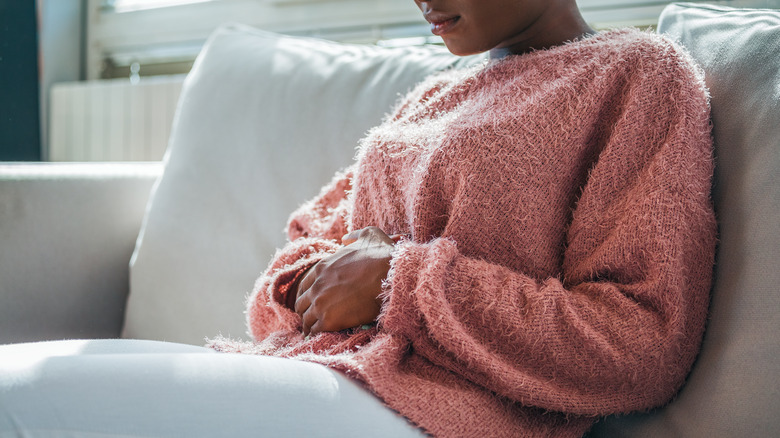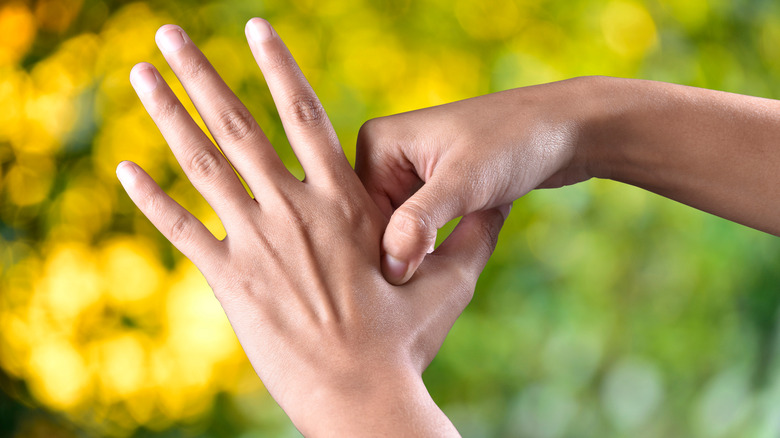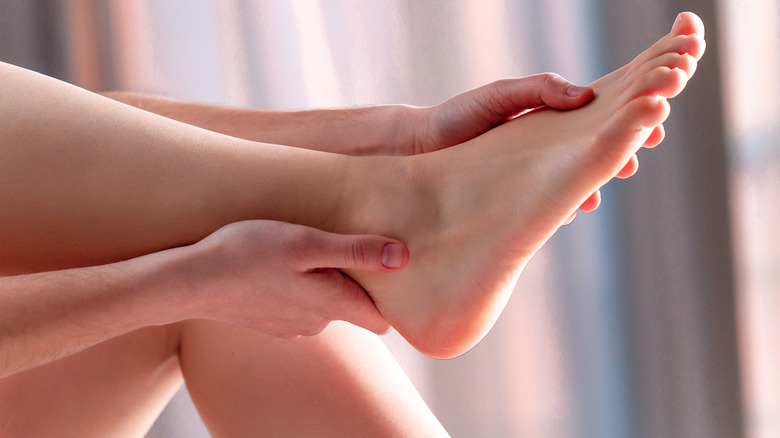Turns Out We Have A Button To Stop Cramps Fast. Here's How To Find It
The experience of menstrual pain, sometimes clinically referred to as dysmenorrhea, can range from person to person in terms of severity and the actual sensation itself, according to a 2012 study published in the Journal of Pain Research. Characterized by cramping in the lower abdomen that comes on prior to or at the start of one's period, some individuals describe the sensation as a dull throbbing, while others liken it to a sharp, stabbing pain.
The exact number of people who experience menstrual pain isn't entirely known, as there are a number of biological and sociocultural factors that play a role in prevalence rates among different populations. However, research suggests that rates fall between 20% and potentially more than 90%. While it's not unusual to experience cramps during one's period, the pain can sometimes be so severe that it impacts the person's ability to go about their day-to-day lives. Results from a 2023 survey conducted by YouGov found that on a scale of 0 to 10 (defined as no pain whatsoever up to excruciating pain), the majority of menstruating women reported a score of 7, with 10% of participants ranking their period pain at an excruciating 10.
Wouldn't it be great if we could simply click an "off" button and say goodbye to painful cramps each month? Acupressure practitioners suggest that we can. In fact, that off button you crave can be found right in your hand, reports HealthShots.
Give the area between your thumb and index finger a squeeze
The practice of acupressure centers around the idea that energy obstructions within the body result in physical pain. Applying pressure to specific points on the body may help clear these obstructions and restore equilibrium to the flow of energy. Subsequently, physical pain is reduced, including pain associated with period cramps. "Self-acupressure is considered effective and helps to achieve a relative reduction in menstrual pain," fertility expert Dr. Gauri Agarwal told HealthShots. However, Dr. Agarwal notes that acupressure isn't a long-term solution to menstrual pain but may instead provide some immediate relief for a couple of hours. On the other hand (pun intended), some experts report that self-acupressure may offer progressively greater degrees of pain relief if practiced over several months, according to Endometriosis New Zealand.
The spot on your hand right between the thumb and the index finger is said to be linked to large-intestine relief. Using medium pressure, massage the area in a circular motion for 60 seconds on one hand before switching to the other. The pressure you apply should be enough so that the area may feel mildly sore afterwards, but not so much that it causes bruising.
What to do if this pressure point doesn't work for you
For this practice to be most effective, Endometriosis New Zealand suggests getting a jumpstart and massaging this pressure point twice daily for five days before you're expected to get your period. Once your period starts, you can implement acupressure as many as five times each day.
However, if this particular pressure point is proving ineffective, consider trying another area of the body besides the hand. This includes the inside of the top of the ankle and the top of your foot, approximately 1 centimeter (cm) below the midway point between the big toe and the first toe. Alternatively, researchers from a 2013 study published in Evidence-based Complementary and Alternative Medicine found that acupressure of the ears may potentially be effective in relieving menstrual pain and related distress in young people with dysmenorrhea.
Aside from acupressure, Mayo Clinic experts suggest individuals struggling with menstrual cramps may alternatively benefit from the use of over-the-counter (OTC) pain-relief medications, hormonal oral contraceptives, or surgery if cramping is related to an underlying health condition such as endometriosis.



